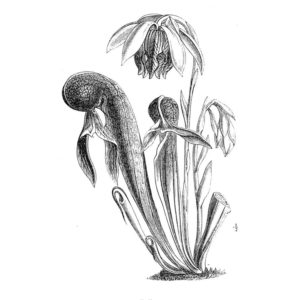The Darlingtonia Midge & Its Murderous Accomplice
Who would believe that an insect and an insect-eating plant could have a mutually beneficial relationship? Surprisingly, that’s exactly the case in the unlikely union between the mosquito-like midge and the carnivorous California pitcher plant (Darlingtonia californica), which is found in serpentine seeps in northern California and Oregon. The midge larvae reside within a watery liquid produced by the plant’s tube-like leaf, and are thought to live nowhere else on earth. The larvae find both refuge from predators and an abundant food source – the insect corpses that have drowned there, lured by the prospect of nectar.
Deadly Tube
The insect prey invariably loses its footing and slips into the abyssal tube of the pitcher plant, which is lined with downward pointing hairs that prevent escape. Whether this spells disaster or delight depends upon the creature’s ability to swim. For aquatic organisms like bacteria, protozoans, mites and fly larvae, the pitcher provides a delightful safe haven. But the inch-long midge larvae is by far the most common and abundant resident; up to 350 have been counted in a single pitcher. The pitcher plant symbiotically benefits from the presence of all these apparent freeloaders because it lacks the digestive enzymes present in many other carnivorous plants like the Venus fly trap, so it lets the insects break down the prey’s tough exoskeleton and muscles.
Since insect prey are abundant for only a short period in the spring, the plant must capture and digest as many as possible, using the help of their invertebrate guests. 
Unmoving, Unbiting
Like other pitcher inhabitants, the midge spends only a phase of its life within these confines. After molting four times, the larva enters an immobile stage, similar to a butterfly’s cocoon – where it is transformed into an adult that emerges some weeks later. It now resembles a mosquito with large feathery antennae and long front legs, but it doesn’t bite. Little is known about the adult, but it probably feeds on pollen and nectar. When sexually mature, the adult female seeks out a young pitcher plant, pierces a hole in it with a needle-like organ called an ovipositor, and deposits her eggs inside, where they will soon hatch into larvae, completing the life cycle of this fascinating insect.
Learn more about the fascinating world of carnivorous plants


